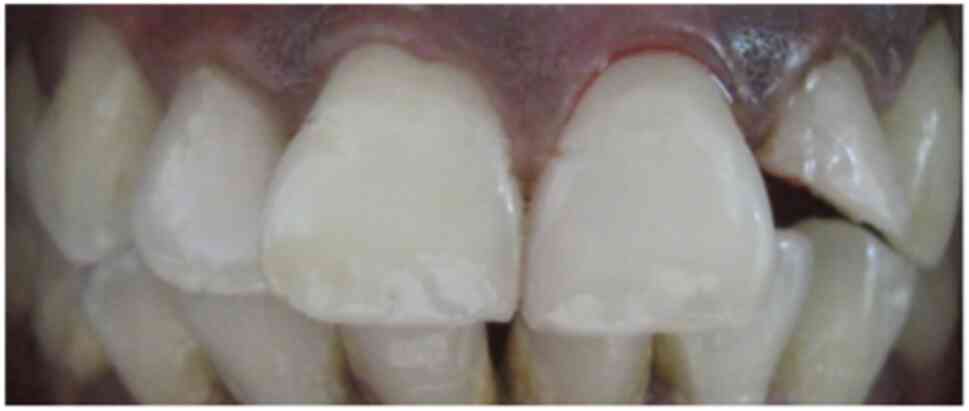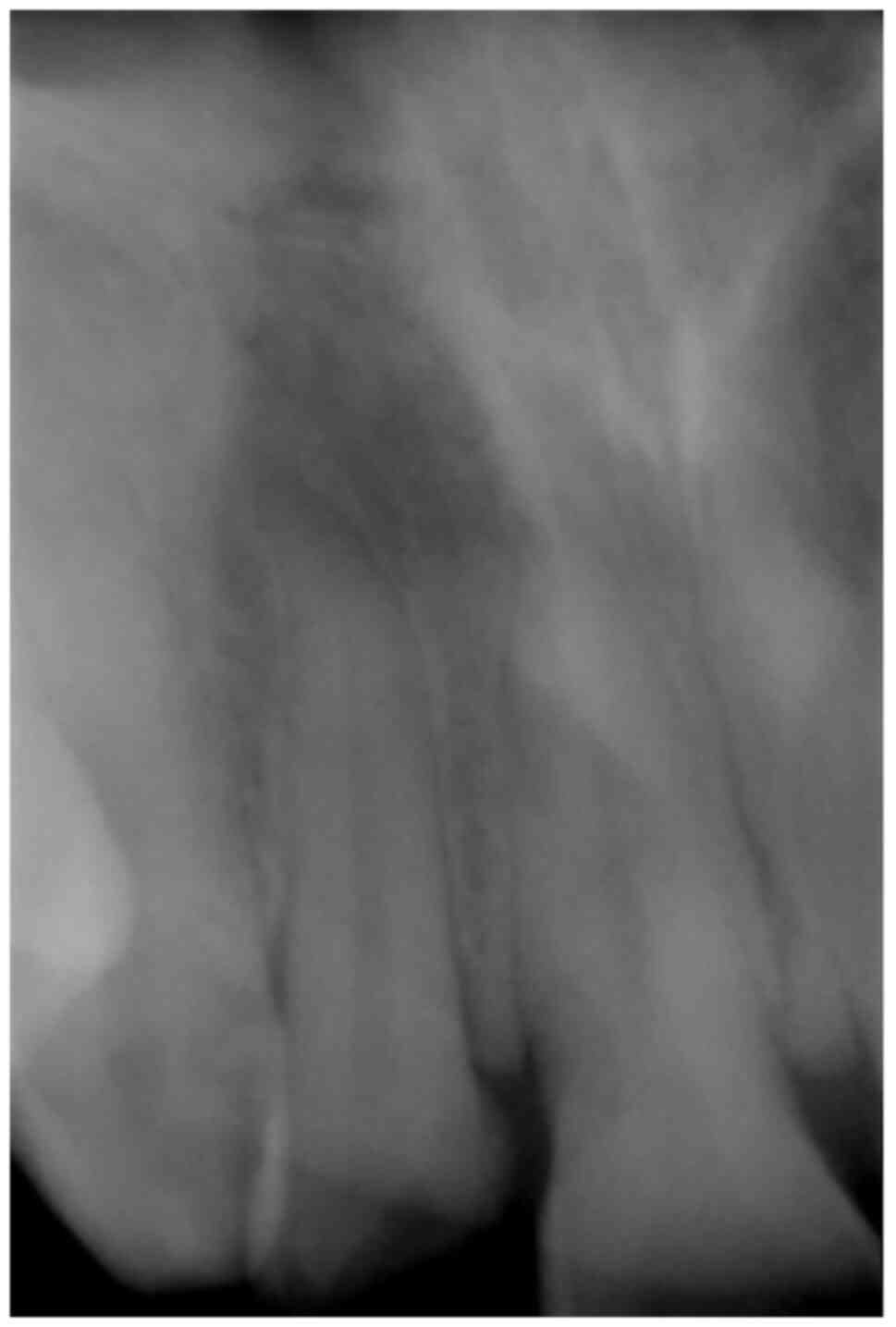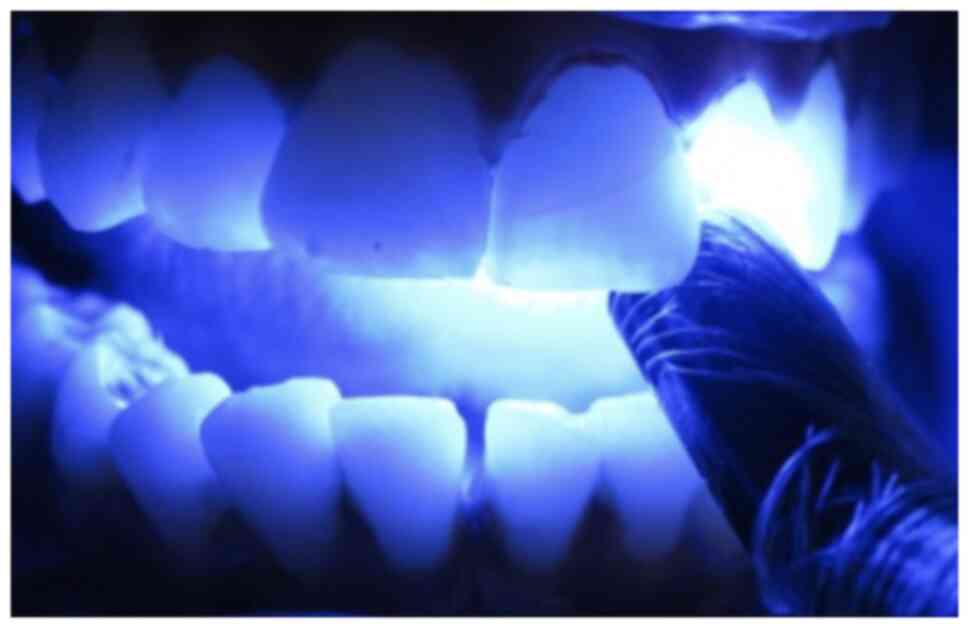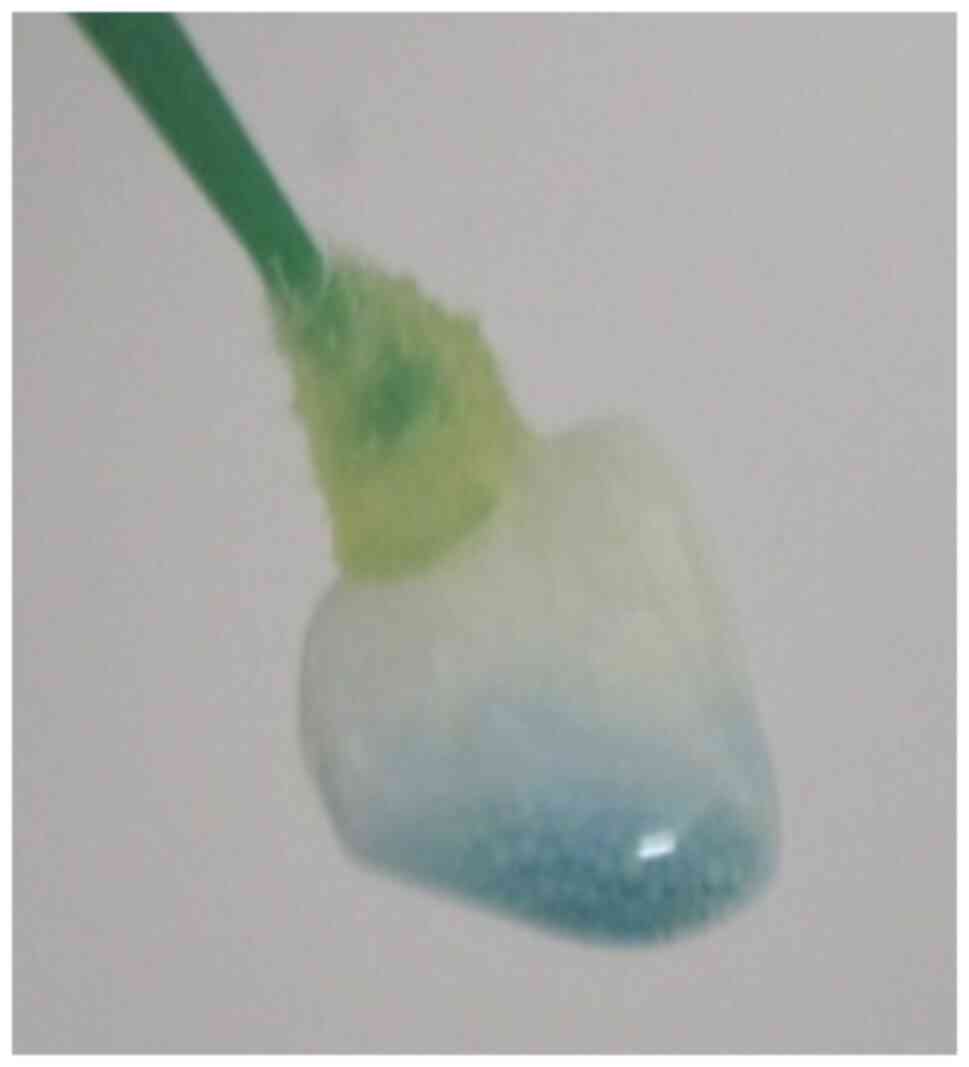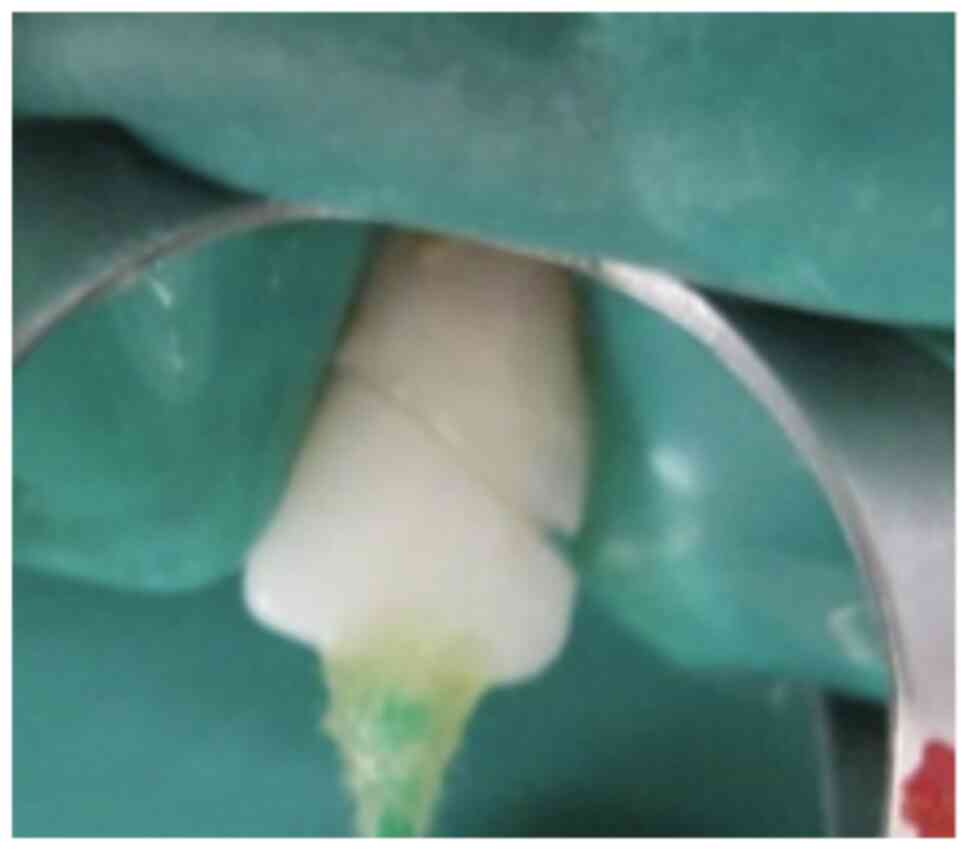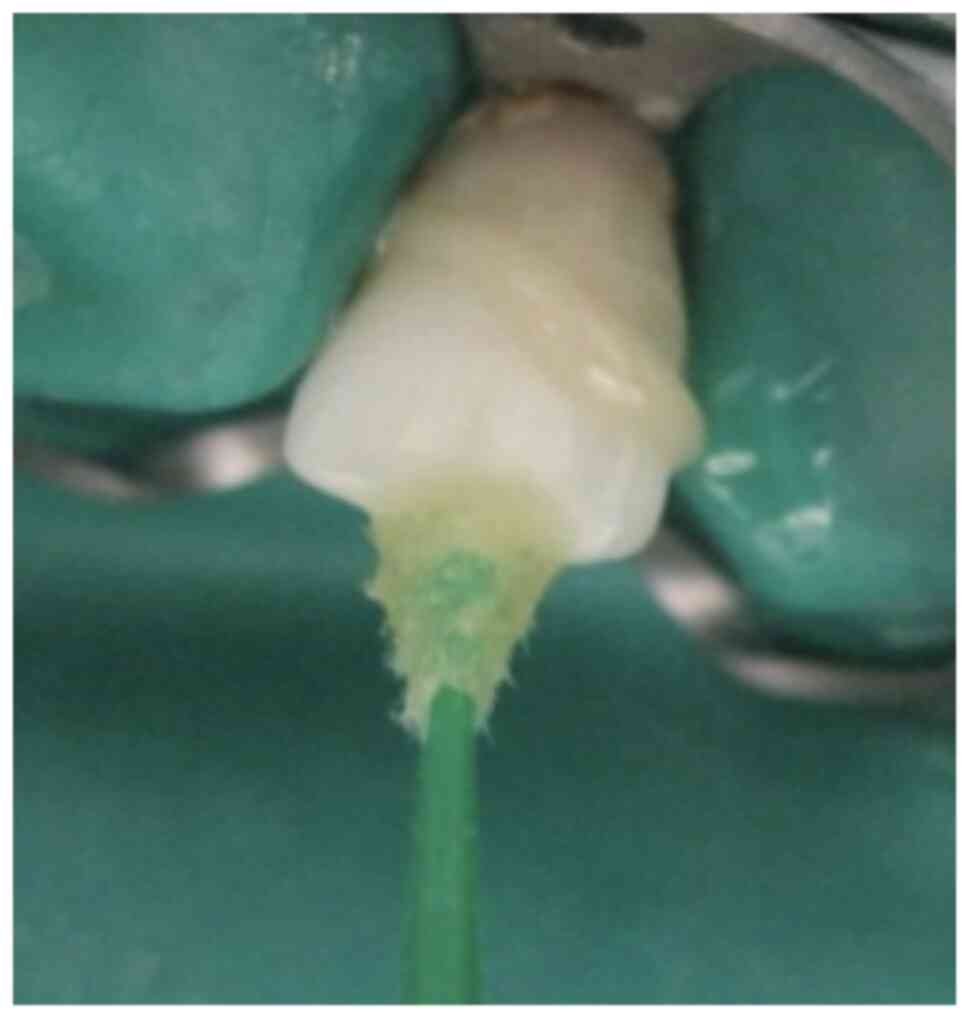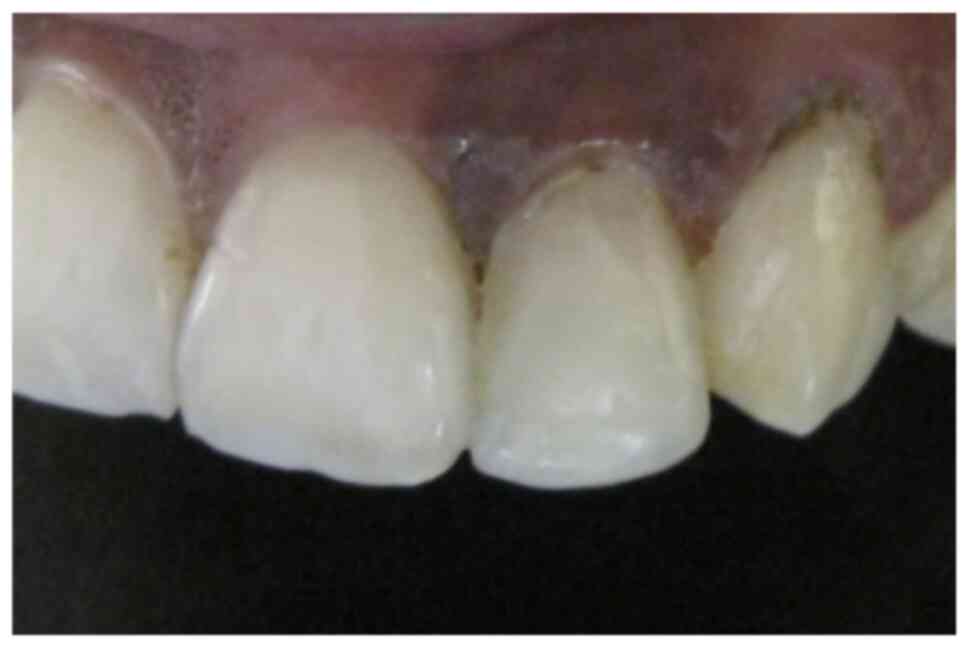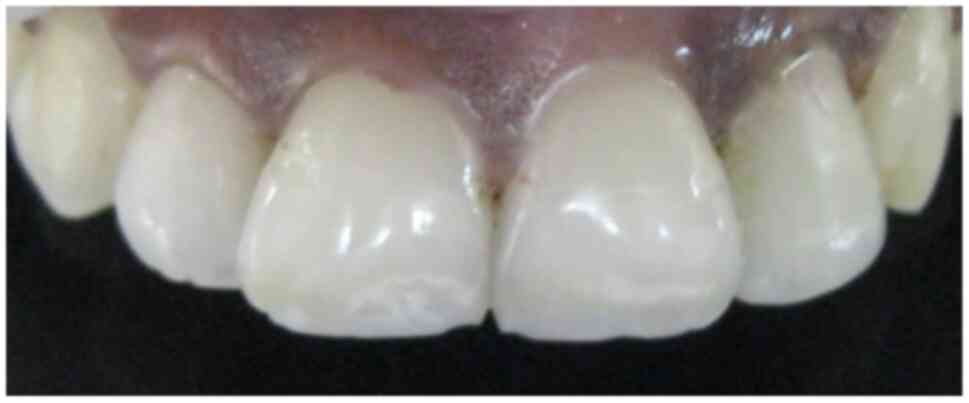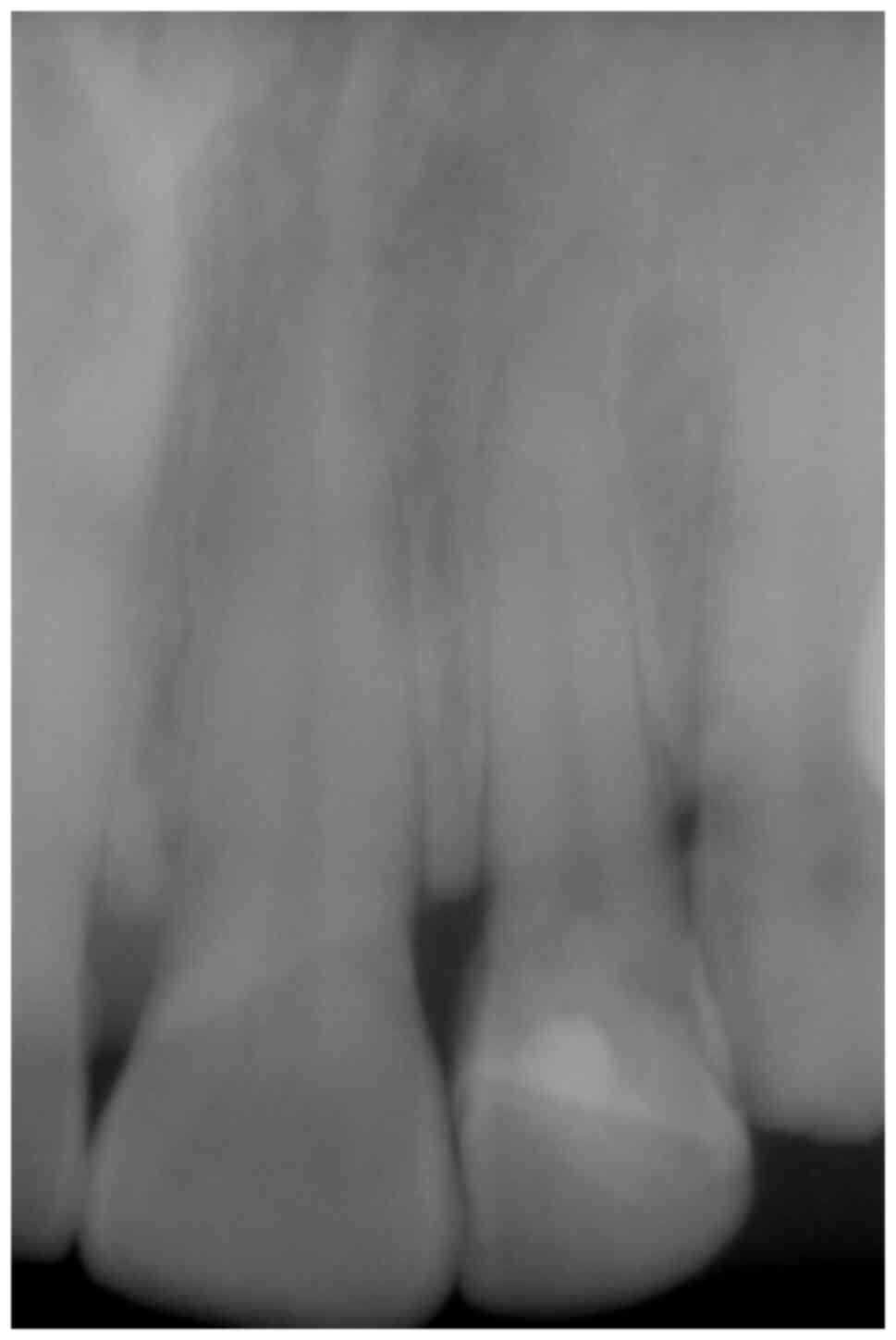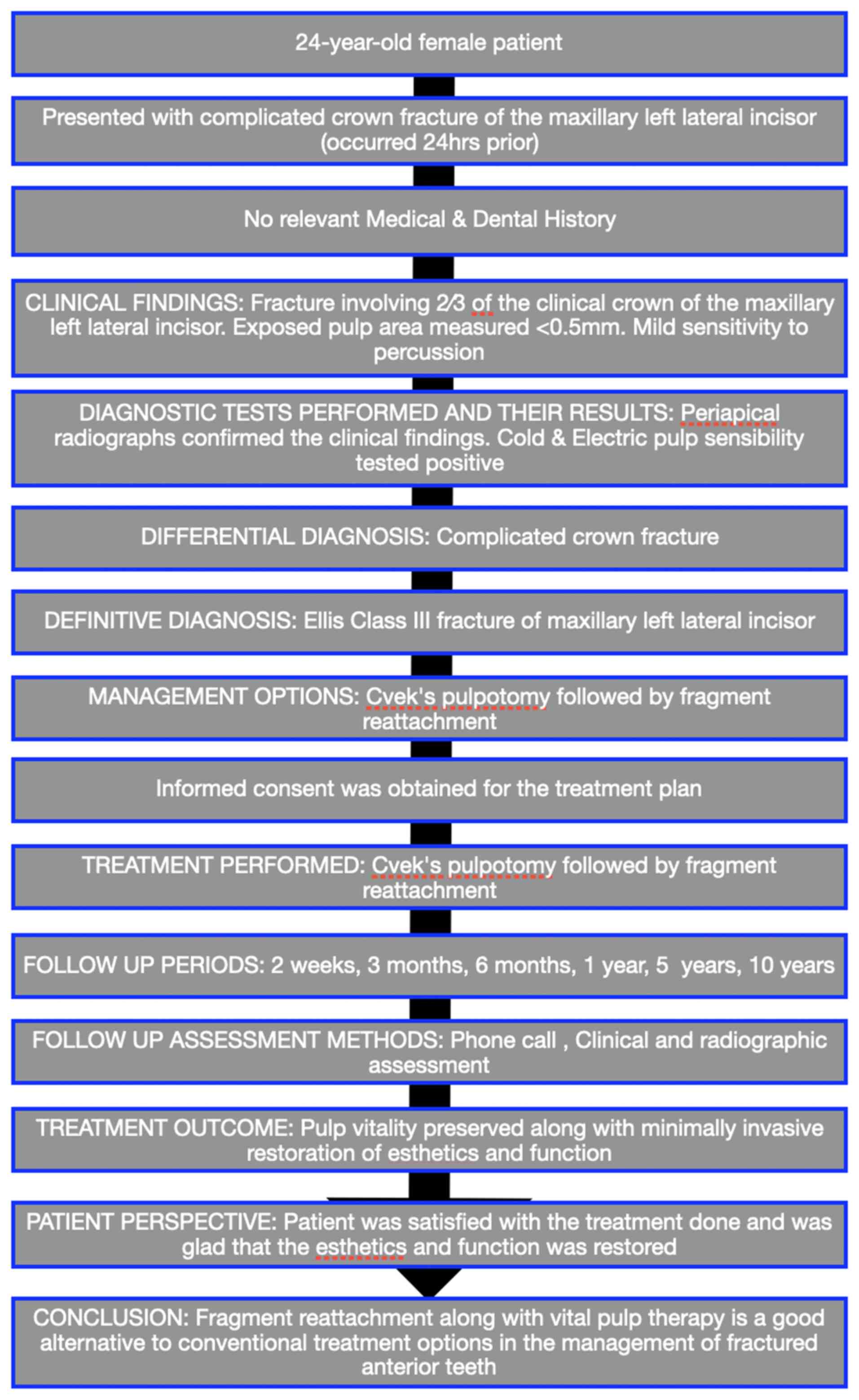Minimal intervention treatment of a complicated crown fracture in a maxillary lateral incisor by partial pulpotomy and fragment reattachment: A case report with a 10‑year follow‑up
- Authors:
- Published online on: June 20, 2024 https://doi.org/10.3892/wasj.2024.257
- Article Number: 42
-
Copyright : © Shetty et al. This is an open access article distributed under the terms of Creative Commons Attribution License [CC BY 4.0].
Abstract
Introduction
Playing a sport can provide benefits, such as an improvement in physical and mental health. It not only helps in stress reduction, but also inculcates teamwork and communication skills. However, sports-related injuries are a global health concern. For instance, the wrist or hand (28%) are the most common sites of injury in children aged 5 to 18 years, followed by the head or face (22%) and the ankle or foot (18%) (1). Orofacial injuries can occur in athletes who engage in fast-paced sports involving close contact with their body, with dental injuries being the commonest of such injuries (2). Of note, one out of five of these traumatic dental injuries are sustained to the permanent teeth. These incidents can have profound consequences on the social and psychological well-being of the patient (3). Maxillary anterior teeth, followed by mandibular anterior teeth are more frequently injured compared with posterior teeth. Individuals with class II division I malocclusion, increased overjet and incompetent lips are more prone to trauma (4). Dental fractures can be classified based on the fracture level and pulpal involvement, as enamel infractions, uncomplicated crown fractures (fractures of enamel-dentin not involving pulp), complicated crown fractures (fractures of enamel-dentin with pulp exposure), crown-root and root fractures (5). The incidence of complicated crown root fractures ranges from 2-13% and uncomplicated crown fractures represent 28-44% of traumatised teeth. The causes of such fractures range from contact sports to domestic abuse, falls, fights and vehicular accidents (6). Ensuring that the form and functionality of the tooth are restored is crucial for the success of restorative planning. Treatment options vary from simple composite restoration to fragment reattachment procedures (7). Restoring fractured teeth has become more predictable owing to the advances made in material science and in preparation techniques. Moreover, the procedure for fragment reattachment has become streamlined owing to breakthroughs in adhesive dentistry. The prognosis depends on the bonding of the viable fragment and its adaptability to the rest of the tooth. Patients have embraced fragment reattachment for its aesthetic rehabilitation benefits, while maintaining the form, contour, alignment, translucence, surface texture and position of the tooth. This minimally invasive and affordable procedure provides additional benefits, including the maintenance of proximal contact, reduced chair time and a positive psychological response (7,8).
Preserving pulpal vitality is crucial for the long-term prognosis of traumatised teeth. Utilising the vital pulp therapy (VPT) interventions that are currently accessible is therefore essential to the management of traumatised teeth. Direct pulp capping, partial (Cvek) pulpotomy, and full pulpotomy are interventions depending on the extent of pulp exposure (9,10). Dental trauma-related pulp exposures typically involve less microbiological contaminants and reduced exposure duration, enhancing the chances of healing. A recent study reported high success rates of VPT interventions for the treatment of traumatised vital permanent teeth (11). The current International Association of Dental Traumatology (IADT) 2020 guidelines advocate for partial pulpotomy or pulp capping as the preferred line of treatment for teeth with complicated crown fractures, with coronal fragment reattachment recommended when the fragment is available (3).
The present case report outlines a treatment for a complicated crown fracture, focusing on biological tissue preservation and minimal intervention principles. The management protocol involved Cvek pulpotomy for pulp preservation and adhesive bonding for reattaching the fracture fragment during restorative treatment.
Case report
A 24-year-old female patient presented to the Department of Conservative Dentistry and Endodontics, A.B Shetty Memorial Institute of Dental Sciences (ABSMIDS), Nitte (Deemed to be University) (Mangalore, India), with a complicated crown fracture of the maxillary left lateral incisor that had occurred 24 h prior during sports activities. Consent for publication was obtained from the patient. The patient did not report any relevant medical or dental history. Extraoral assessment revealed no signs of soft tissue injury. Intraoral examination demonstrated an Ellis class III fracture involving 2⁄3 of the clinical crown of the maxillary left lateral incisor (Fig. 1). Periapical radiographs revealed mature apices with no evidence of root fractures or peri-radicular injury (Fig. 2). The maxillary left central incisor exhibited a craze line upon transillumination (Fig. 3). The exposed pulp area on the maxillary left lateral incisor measured ~2 mm with a positive electric pulp sensibility test, indicating reversible pulpitis. A diagnosis of a complicated crown fracture with pulp exposure was made. The patient reported mild symptoms, including sensitivity to percussion (Table I).
The treatment objectives focused on preserving pulp vitality along with the restoration of function and aesthetics. The selected comprehensive plan incorporated the Cvek pulpotomy (3,12) using Biodentine™ (Septodont USA) to treat the pulp and reattachment of the available tooth fracture using resin composite. A consent form was signed by the patient following the approval of the proposed protocol and treatment was immediately initiated. Pre-procedural radiographs, sensibility assessment, and try-in of fragments aided treatment planning. The fragment was maintained in saline solution to prevent dehydration of the dentin. Following isolation under rubber dam, ~2 mm of the coronal pulp was amputated using a sterile spoon excavator (EXC18, HuFriedyGroup) and the pulpal floor was treated with sodium hypochlorite to arrest the bleeding. Biodentine™ (Septodont USA) was placed followed by a Glass ionomer cement (GlasIonomer FX Ultra, Shofu Dental India) seal (Fig. 4). The fractured fragment was bonded to the tooth by etching with 37% phosphoric acid gel (Prime Dental Products Pvt. Ltd.) (Fig. 5) followed by the application of bonding agent (Adper Single Bond 2, 3M ESPE). The remaining coronal tooth fragment was etched and bonded as well to receive the fragment, which was reattached using flowable nanocomposite (Endure Flow, Septodont USA) (Fig. 6, Fig. 7 and Fig. 8). The patient was unable to attend regular follow-ups due to distance constraints, as the patient worked in another country. Thus, follow-ups were made via telephone inquiries. However, the patient visited the dental clinic after 10 years for a regular check-up. At the 10-year follow-up, the reattached fragment exhibited excellent retention with desired aesthetics. A clinical examination revealed normal soft tissues, tooth form/contour and crown coloration, with no signs of fracture (Fig. 9). Periapical radiographs at the 10-year follow-up revealed a distinct dentin bridge with maintained pulp space with no signs of periapical radiolucency (Fig. 10). Sensibility tests were within normal limits. A comprehensive evaluation of adjacent hard/soft tissues did not reveal any pathology. Clinical photographs attested to the natural appearance of the reattached tooth segment. Based on multiple assessments over the 10-year period, the tooth was deemed to have a favourable prognosis regarding continued pulp vitality and periapical health without the need for further treatment (Table II). The combined approach integrating adhesive techniques with vital pulp treatment demonstrated a successful long-term outcome in the management of a complicated crown fracture in an anterior maxillary tooth (Fig. 11)
Discussion
Traumatic crown fractures in anterior teeth causing pulp exposure are distressing injuries requiring prompt care, particularly in young patients. Unlike caries exposures, traumatic cases tend to have a better prognosis due to the lack of bacteria. Treatment options for such pulp exposures include direct pulp capping or partial/full pulpotomy, depending on extent of inflammation, root development stage and vascular supply. Although the time between injury and treatment along with exposure size can influence outcomes, studies have demonstrated that partial pulpotomy can be successful, despite delays if the infected pulp is removed (13,14). Exposures >1 mm where treatment is delayed beyond 24 h are managed more effectively with Cvek pulpotomy involving the removal of 1-2 mm inflamed pulp until healthy tissue is reached (12). Partial pulpotomy preserves coronal pulp tissue with a greater healing capacity. The remaining crown pulp can maintain physiologic dentin formation, strengthening the tooth (9,10).
For pulp capping, calcium hydroxide has been the preferred material due to its antibacterial alkaline pH that supports healing and hard tissue formation. However, it requires technique sensitivity, can be difficult to apply, and lacks cost-effectiveness of contemporary alternatives (15). Currently, mineral trioxide aggregate (MTA) and Biodentine are preferred over calcium hydroxide for VPT in primary and permanent teeth (16). Although effective, an adverse effect of MTA is potential tooth discoloration due to the radiopacifier, bismuth oxide, in grey and white formulations. Biodentine can also stain teeth, although seemingly less than MTA (17).
Material selection, including the adhesive strategy (etch type) and resin (conventional, flowable, pre-heated, etc.) also markedly affect the success (7,8,18). Flowable composites are suitable when adaptation and interfacial gaps are minimal (19). Maintaining fragment hydration is also critical, as moisture loss reduces bond strength (20). In the case presented herein, the reattachment was performed using a total-etch single bottle adhesive and flowable composite owing to excellent fracture adaptation. Storing fragments in saline prevented dehydration and related discoloration. The decision to perform partial pulpotomy considered the time from injury to treatment, the age of the patient, root status and marginal fit of fragments that assured pulp dressing retention. Hence, Biodentine was applied as the capping agent. At the 10-year follow-up, there was no evidence of coronal or reattachment line discolouration. The teeth exhibited normal sensibility with no periapical pathosis signs/symptoms indicating success.
Advances made in restorative materials, tooth preparation designs and bonding protocols have enabled predictable restoration of fractured teeth using various approaches tailored to factors, such as economics, age and oral status. Proper occlusal rehabilitation following trauma is vital for stomatognathic function, facial symmetry, speech, swallowing and preventing dental/skeletal discrepancies over time. Here, the own fragments of the patient were reattached, unlike more invasive veneers or crowns. Numerous techniques and materials to reattach fragments exist, with some researchers promoting additional tooth preparation to increase fracture resistance compared to bonding alone (21). However, there is evidence to indicate that no preparation or only chamfering still retains adequate strength (8). Ultimately, there is no consensus on an ideal reattachment technique with choice depending on fracture and marginal adaptation quality (7,22).
In conclusion, as demonstrated in the case described in the present study, fragment reattachment in conjugation with VPT stands out as a favourable alternative to traditional treatment approaches for the management of fractured anterior teeth. This method is straightforward, minimally invasive, and ensures both effective retention of the fragment and pleasing aesthetics, all while preserving the integrity of the pulp tissue.
Acknowledgements
Not applicable.
Funding
Funding: No funding was received.
Availability of data and materials
Data sharing is not applicable to this article as no datasets were generated or analyzed during the current study.
Authors' contributions
PS conceptualized the study and was involved in the clinical analysis of the patient. MP was involved in the curation of the patient's data. RB was involved in the writing and preparation of the original draft of the manuscript, performed the treatment procedure, obtained medical images, as well as in the reviewing and editing of the manuscript. All authors have reviewed, and read and approved the final manuscript.
Ethics approval and consent to participate
Informed consent had been obtained from the patient following the explanation of the treatment outcomes.
Patient consent for publication
Informed consent had been obtained from the patient for the publication of the present case report and any related images.
Competing interests
The authors declare that they have no competing interests.
References
|
Taylor BI and Attia MW: Sports-related injuries in children. Acad Emerg Med. 7:1376–1382. 2000.PubMed/NCBI View Article : Google Scholar | |
|
Emerich K and Kaczmarek J: First aid for dental trauma caused by sports activities: State of knowledge, treatment and prevention. Sports Med. 40:361–366. 2010.PubMed/NCBI View Article : Google Scholar | |
|
Bourguignon C, Cohenca N, Lauridsen E, Flores MT, O'Connell AC, Day PF, Tsilingaridis G, Abbott PV, Fouad AF, Hicks L, et al: International association of dental traumatology guidelines for the management of traumatic dental injuries: 1. Fractures and luxations. Dent Traumatol. 36:314–330. 2020.PubMed/NCBI View Article : Google Scholar | |
|
Jones LC: Dental trauma. Oral Maxillofac Surg Clin North Am. 32:631–638. 2020.PubMed/NCBI View Article : Google Scholar | |
|
DiAngelis AJ, Andreasen JO, Ebeleseder KA, Kenny DJ, Trope M, Sigurdsson A, Andersson L, Bourguignon C, Flores MT, Hicks ML, et al: Guidelines for the management of traumatic dental injuries: 1. Fractures and luxations of permanent teeth. Pediatr Dent. 38:358–368. 2016.PubMed/NCBI | |
|
Levin L, Day PF, Hicks L, O'Connell A, Fouad AF, Bourguignon C and Abbott PV: International association of dental traumatology guidelines for the management of traumatic dental injuries: General introduction. Dent Traumatol. 36:309–313. 2020.PubMed/NCBI View Article : Google Scholar | |
|
Garcia FCP, Poubel DLN, Almeida JCF, Toledo IP, Poi WR, Guerra ENS and Rezende LVML: Tooth fragment reattachment techniques-A systematic review. Dent Traumatol. 34:135–143. 2018.PubMed/NCBI View Article : Google Scholar | |
|
Bruschi-Alonso RC, Alonso RCB, Correr GM, Alves MC, Lewgoy HR, Sinhoreti MAC, Puppin-Rontani RM and Correr-Sobrinho L: Reattachment of anterior fractured teeth: Effect of materials and techniques on impact strength. Dent Traumatol. 26:315–322. 2010.PubMed/NCBI View Article : Google Scholar | |
|
European Society of Endodontology (ESE) developed by. Duncan HF, Galler KM, Tomson PL, Simon S, El-Karim I, Kundzina R, Krastl G, Dammaschke T, Fransson H, et al: European society of endodontology position statement: Management of deep caries and the exposed pulp. Int Endod J. 52:923–934. 2019.PubMed/NCBI View Article : Google Scholar | |
|
Duncan HF: Present status and future directions-vital pulp treatment and pulp preservation strategies. Int Endod J. 55 (Suppl 3):S497–S511. 2022.PubMed/NCBI View Article : Google Scholar | |
|
Krastl G, Weiger R, Ebeleseder K and Galler K: Present status and future directions: Endodontic management of traumatic injuries to permanent teeth. Int Endod J. 55 (Suppl 4):S1003–S1019. 2022.PubMed/NCBI View Article : Google Scholar | |
|
Bimstein E and Rotstein I: Cvek pulpotomy-revisited. Dent Traumatol. 32:438–442. 2016.PubMed/NCBI View Article : Google Scholar | |
|
Matoug-Elwerfelli M, ElSheshtawy AS, Duggal M, Tong HJ and Nazzal H: Vital pulp treatment for traumatized permanent teeth: A systematic review. Int Endod J. 55:613–629. 2022.PubMed/NCBI View Article : Google Scholar | |
|
Qudeimat MA, Alyahya A and Hasan AA: Mineral trioxide aggregate pulpotomy for permanent molars with clinical signs indicative of irreversible pulpitis: A preliminary study. Int Endod J. 50:126–134. 2017.PubMed/NCBI View Article : Google Scholar | |
|
Mohammadi Z and Dummer PMH: Properties and applications of calcium hydroxide in endodontics and dental traumatology. Int Endod J. 44:697–730. 2011.PubMed/NCBI View Article : Google Scholar | |
|
Parirokh M, Torabinejad M and Dummer PMH: Mineral trioxide aggregate and other bioactive endodontic cements: An updated overview-part I: Vital pulp therapy. Int Endod J. 51:177–205. 2018.PubMed/NCBI View Article : Google Scholar | |
|
Pednekar A, Ataide I, Fernandes M, Lambor R and Soares R: Spectrophotometric analysis of coronal discolouration induced by ProRoot MTA, biodentine and MTA repair HP used for pulpotomy procedures. Eur Endod J. 6:189–196. 2021.PubMed/NCBI View Article : Google Scholar | |
|
Pereira RV, Tabata LF, Rosemberg ET, Ribeiro APD, Poubel DLDN and Garcia FCP: Fragment reattachment or direct restoration? An in vitro study. Dent Traumatol. 39:257–263. 2023.PubMed/NCBI View Article : Google Scholar | |
|
Farik B, Munksgaard EC, Andreasen JO and Kreiborg S: Fractured teeth bonded with dentin adhesives with and without unfilled resin. Dent Traumatol. 18:66–69. 2002.PubMed/NCBI View Article : Google Scholar | |
|
Madhubala A, Tewari N, Mathur VP and Bansal K: Comparative evaluation of fracture resistance using two rehydration protocols for fragment reattachment in uncomplicated crown fractures. Dent Traumatol. 35:199–203. 2019.PubMed/NCBI View Article : Google Scholar | |
|
Stellini E, Stomaci D, Stomaci M, Petrone N and Favero L: Fracture strength of tooth fragment reattachments with postpone bevel and overcontour reconstruction. Dent Traumatol. 24:283–288. 2008.PubMed/NCBI View Article : Google Scholar | |
|
de Sousa APBR, França K, de Lucas Rezende LVM, do Nascimento Poubel DL, Almeida JCF, de Toledo IP and Garcia FCP: In vitro tooth reattachment techniques: A systematic review. Dent Traumatol. 34:297–310. 2018.PubMed/NCBI View Article : Google Scholar |



